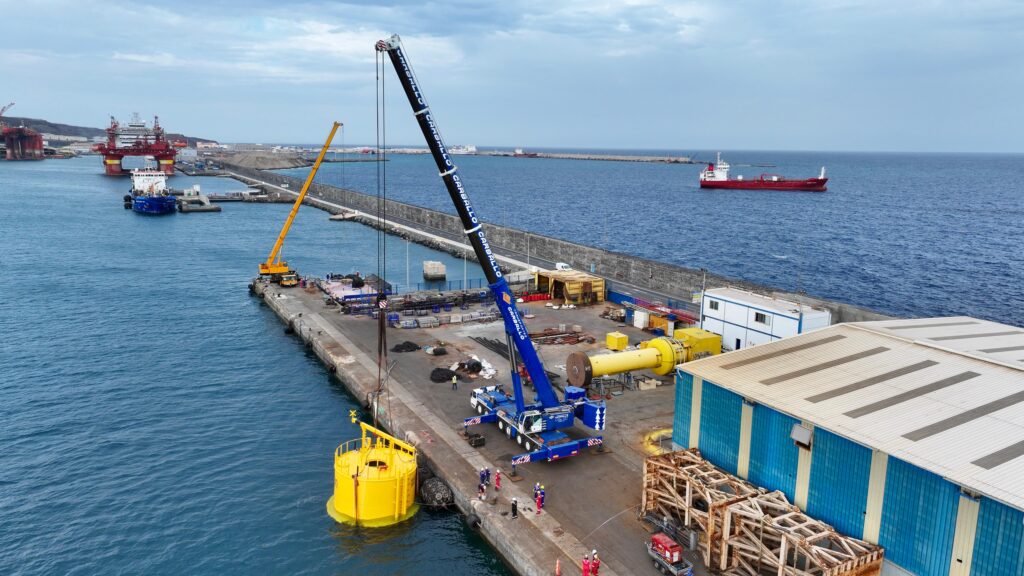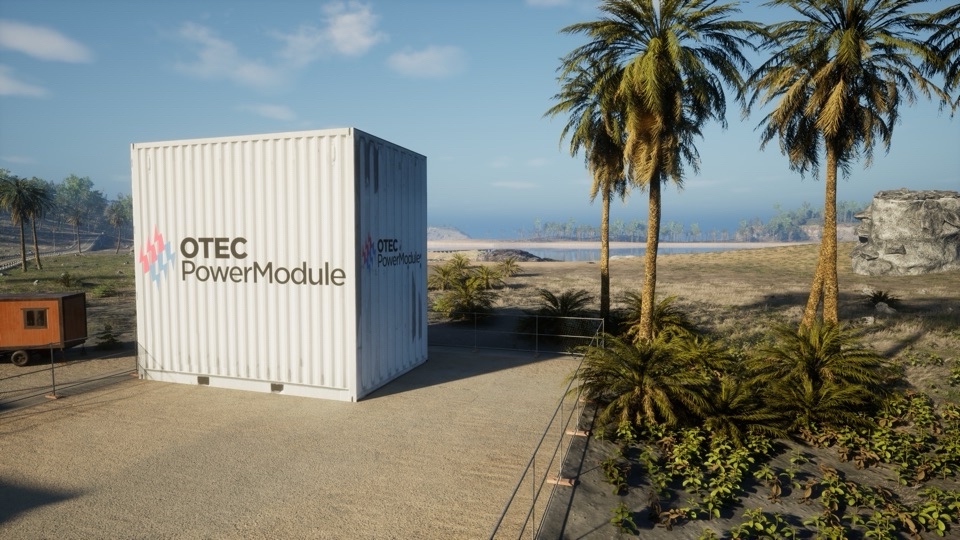By Dan Grech, Founder and CEO
7 April 2025 – We are excited to share more about what Global OTEC is building: a modular offshore renewable energy platform that taps into one of the most underutilised natural resources on Earth — the temperature difference in tropical oceans. Our OTEC Power Module® transforms this temperature gradient into reliable baseload power, unlocking terawatts of affordable, sustainable energy for industry, compute and utility plays globally.
Why does this matter?
- Provides clean, 24/7 renewable power where wind and solar struggle, even with battery storage
- Presents a strategic decarbonisation opportunity for deepwater oil and gas platforms, where grid access is cost prohibitive, and fossil fuel reliance remains high
- Unlocks new co-located industries such as data centres, industrial cooling, desalination, power-to-X, and carbon capture
This Litepaper offers a concise overview of the thesis behind Global OTEC, and why the journey to OTEC’s commercialisation is inevitable, not hypothetical. We hope you’ll join us on this transformative journey.
The Energy Gap for the Tropics
While much of the world races to decarbonise using wind and solar, many regions—particularly in the tropics—face a dual challenge: a lack of consistent baseload power and a rising industrial energy demand.
Tropical islands and coastal nations continue to rely on large diesel generators, which cost upwards of $0.30–$0.50/kWh and contribute significantly to carbon emissions and air pollution [1]. These same challenges are now being mirrored in coastal industrial zones and offshore infrastructure, where energy demand is growing but grid access and clean alternatives remain limited.
At the same time, industries such as data centres, green fuel production, desalination, and carbon capture require high reliability and continuous energy. Battery-backed solar and wind cannot deliver this at the required scale without prohibitive storage costs or excessive land usage.
Ocean Thermal Energy Conversion (OTEC) offers a highly compelling answer. It leverages the consistent temperature difference between warm surface water and cold deep seawater found in tropical regions to generate electricity. This resource is vast, predictable, and available 24/7—making it ideally suited not just for remote communities, but for the coming wave of industrial decarbonisation.

Despite being technically viable for decades — with the first successful onshore plants built in Japan and Hawaii in 2013 and 2015 respectively — OTEC has struggled with commercialisation due to high upfront costs and engineering complexity.

Why Global OTEC Exists
We believe the missing piece isn’t the fundamental science behind OTEC, it’s the business model, the hardware stack, and the execution.
Many past OTEC efforts tried to leap directly to multi-megawatt, government-funded infrastructure without fully addressing technical and commercial risks. Many also relied on subsidies, legacy subsystems and off-the-shelf components originally developed for other applications.
At Global OTEC, we are not merely assembling known parts—we’re integrating next-generation components that are tailor-made for the specific heat exchange, fluid dynamics, and energy conversion requirements of OTEC. This shift redefines the performance envelope and renders much of the historical scepticism around OTEC redundant.
This is a paradigm shift. By adopting new materials, higher-efficiency heat exchangers, and digital integration from the ground up, we’re charting a new course that avoids the cost traps of earlier generations and unlocks a viable commercial pathway.
Our approach is different:
- Modularisation: We’ve developed the OTEC Power Module®, a 500kW unit that can be scaled by stacking clusters of modules on floating platforms.
- De-risking first: Our roadmap starts with a low-risk, land-based demonstration before scaling offshore with deepwater experts.
- Private-sector partnerships: We’re co-developing projects with oil & gas, utilities, and heavy industry to drive adoption.
The OTEC Power Module®
Our proprietary OTEC Power Module® is the world’s first modularised, offshore OTEC system. It uses closed-cycle Rankine heat engines to generate power from the ocean’s thermal gradient.
Key features:
- 500kW capacity per module, scalable to 1–50MW
- Standardised and prefabricated for cost-effective deployment
- Floatable on offshore platforms, enabling co-location with oil and gas infrastructure, data centres, power-to-X or other coastal demand centres, like ports and marinas
- Optimised through collaborations with leading waste heat recovery manufacturers for next-generation OTEC components
This approach makes OTEC bankable and repeatable, rather than these one-off mega engineering experiments which rarely go beyond feasibility studies.
Pathway to Commercialisation
OTEC is crossing the “valley of death” between proven concept and viable commercial model. We’ve built a four-phase roadmap to overcome that:
Phase 1: Demonstration
- 500kW land-based demonstration plant
- Site with pre-installed seawater infrastructure
- Non Dilutive Joint Industry Project (JIP) funding model
- Outputs: Proof-of-concept, operational data, investor confidence

Phase 2: Early Commercialisation
- 1–2MW offshore OTEC hub
- First-of-a-kind offshore deployment
- Commercial arrangements with oil and gas partners
- Integration with co-located uses (e.g. oil and gas production, green fuels, CCUS)

Phase 3: Commercialisation
- 2–10MW projects
- Wider offshore energy production applications
- Unlocks blended finance (climate infra funds, DFIs,)
- Serving island utilities and coastal communities

Phase 4: Large-Scale Deployment
- 10–50MW projects
- Powering data centres, industrial clusters, and regional grids
- Supported by sovereign wealth and infrastructure funds
Economics, Scale, and Global Relevance
OTEC is not a fringe concept or a niche play—it is a globally scalable solution for decarbonisation, particularly in the tropics. Simulation models show that the Levelised Cost of Electricity (LCOE) for OTEC can fall as low as 0.062–0.069 US$/kWh by 2050 as the technology matures through learning rates and industrial scaling [2].
Similarly, the U.S. Department of Energy (2021) highlights OTEC’s theoretical global capacity as exceeding 10 terawatts—more than the world’s total current installed electricity generation [5]. The IEA describes OTEC as a “virtually limitless and continuous supply of baseload renewable energy in tropical regions” [3].
Further reinforcing this, the United Nations Industrial Development Organization (UNIDO) sees OTEC as a platform technology for industrial decarbonisation, enabling co-located green hydrogen, desalination, and cooling infrastructure [7]. IRENA echoes this potential, stating that OTEC can be cost-competitive with diesel and bring energy resilience to island nations [6].
This validation across academic, governmental, and intergovernmental bodies supports our conviction that OTEC is not just an interesting technology—it’s an essential part of the global energy transition

OTEC operates at capacity factors above 90%, a rarity among renewables [3]. Our cost-reduction plan draws learnings from the offshore wind sector:
- Modular scaling: Enables standardisation and faster replication
- Procurement strategies: Can lower CAPEX by 20–30% [4]
- Double-stacked modules: Increase output per platform
- Digital Twins and IoT: Streamlines maintenance and predictive analytics

These numbers become even more attractive when accounting for co-location benefits and carbon revenues.
Financing costs can represent 50% or more of total energy infrastructure project costs. This is why Global OTEC is pursuing joint industry projects (JIPs) and public-private models with capital-strong and sustainability-conscious partners, such as oil and gas operators and sovereign wealth funds, who may ultimately build and operate these assets.

More Than Just Power
Because of its unique offshore setting and consistent thermal output, OTEC unlocks additional diverse applications:
- Desalination using waste cold water
- Cooling for coastal data centres, expanding locations
- Green hydrogen and ammonia production
- Carbon removal from seawater
- Aquaculture & agriculture via nutrient-rich deep water
These synergies make each project more financially resilient and attractive to a wider customer and investor base.
Join the Journey
Global OTEC has already raised over $6.5 million, mostly non-dilutive funding, from public and private sources, including the EU Horizon Europe programme. Our first step was to de-risk the floating platform required for facilitating OTEC projects anywhere in the world. Now that’s built, we’re working with oil and gas majors, governments, and tier-one engineering firms to bring OTEC to commercial reality.
We’re now seeking:
- Joint Industry Project partners
- Offshore deployment collaborators
- Policy champions to support market and financial frameworks
The time to scale ocean thermal energy is now.
Global OTEC: Baseload Energy for the Age of Electrification.
References
[1] International Renewable Energy Agency (IRENA). Renewable Energy for Islands. 2020.
[2] Lager, J., Quist, J., Blok, K. Upscaling Scenarios for Ocean Thermal Energy Conversion with Technological Learning in Indonesia and their Global Relevance. Renewable and Sustainable Energy Reviews. 2022; 158:112086. https://doi.org/10.1016/j.rser.2022.112086
[3] International Energy Agency – Ocean Energy Systems (IEA-OES). International LCOE for Ocean Technologies. 2015.
[4] Fluor Corporation. Internal Benchmarking Study. 2023.
[5] U.S. Department of Energy. Ocean Thermal Energy Conversion Research and Development. 2021. Available at: energy.gov
[6] International Renewable Energy Agency (IRENA). The Role of Ocean Energy Technologies in Decarbonizing Island Nations. 2014.
[7] United Nations Industrial Development Organization (UNIDO). Renewable Energy in Island and Remote Communities. 2022.
read our latest news and blog posts:
- Ocean Energy Education brought to Barbadian Students for World Ocean Day
- Offshore electrification through the ocean: how OTEC can provide clean baseload power 24/7 to operations at SeA
- The Baseload Power Source Almost No One Is Talking About
- Global OTEC announces world’s largest onshore OTEC demonstration plant to date
- Over a Century in the Making: A Brief Journey Through OTEC’s History
subscribe to our newsletter
Newsletter
"*" indicates required fields


